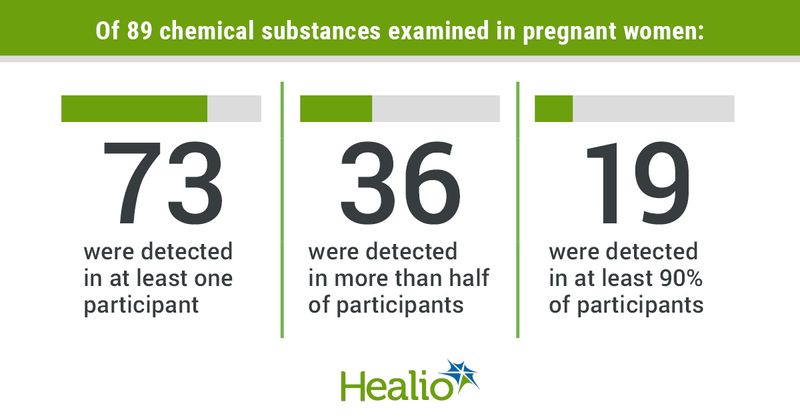Chemical exposure during pregnancy increasing over time
Exposure to certain chemicals during pregnancy has increased over the past 12 years, with Hispanic women being exposed to higher levels of some chemicals, according to data published in Environmental Science & Technology.
“Many of these chemicals — like phthalates and bisphenols — are known to harm development,” Tracey Woodruff, PhD, MPH, study author and professor of OB/GYN and reproductive sciences at the University of California, San Francisco, told Healio. “Our study comes on the heels of reports that we are about to cross a planetary boundary in terms of how many industrial chemicals our environment can sustain, yet chemical production and use continues to rise.”

Buckley and colleagues analyzed the urine samples of 171 pregnant women across the United States who were enrolled in the NIH’s Environmental influences on Child Health Outcomes Program, or ECHO — specifically in California, Georgia, Illinois, New Hampshire, New York and Puerto Rico. The urine samples were collected between 2008 and 2020, with most collected between 2017 and 2020.
The researchers chose 89 chemical substances for analysis, including 79 individual and 10 composite analytes. These corresponded with 103 chemicals.
The participants were aged 29.5 years on average and were mostly non-Hispanic white (34%) or Hispanic (40%) and married or living with their partner (68%).
Chemical detection
In total, 73 analytes (63 individual and 10 composite) were detected in at least one participant, 36 (31 individual and five composite) were detected in more than half of participants, and 19 (17 individual and two composite) were detected in at least 90% of participants.
Of note, nine of the 36 analytes detected in most participants are not included in the National Health and Nutrition Examination Survey’s routine chemical surveying, according to the researchers.
Although the detection of certain chemicals — such as benzophenone-8 and nitenpyram — decreased over the study period, other chemicals, including bisphenol F, were detected more frequently as time passed.
“Chemical exposures from plastics, pesticides and replacement chemicals are rising in pregnant women,” Woodruff warned.
Exposure levels based on race, ethnicity
Chemical exposure was greater for women of races and ethnicities other than non-Hispanic white (n = 30 analytes), with Hispanic women having greater exposure to most of the analytes that were not included in NHANES, according to the researchers.
“We speculate that Latinas in our study may have relied more on processed foods and certain personal care products, but more research is needed,” Jessie P. Buckley, PhD, MPH, lead author and an associate professor of environmental health and engineering at Johns Hopkins University Bloomberg School of Public Health, told Healio.
Exposure was also higher for participants with lower education status (n = 22 analytes), participants who were unmarried but partnered (n = 11 analytes) and participants with higher urinary cotinine concentrations (n = 12).
“Based on these findings, it’s worth emphasizing the importance of avoiding plastics and pesticides, but individual actions can only do so much,” Woodruff told Healio. “And, frankly, the burden shouldn’t be on individuals. It is nearly impossible to avoid plastics today. We need systemic change so that we are not drowning in a sea of harmful chemicals.”

